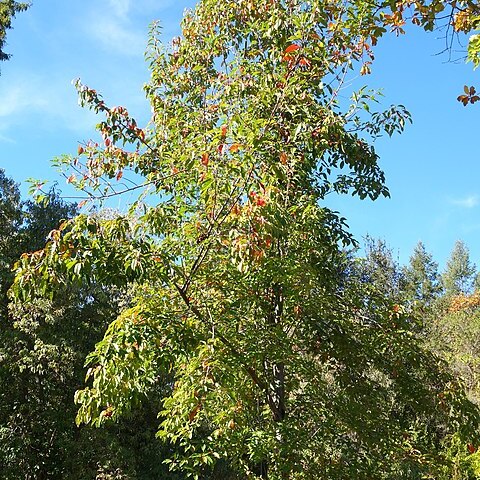Trees to 15 m tall. Branchlets grayish brown or purplish brown when old, terete, villous when young, glabrous when old; buds reddish purple, ovoid, pubescent or only pubescent along margin of scales. Stipules caducous, linear-lanceolate, membranous, glabrous, margin entire, apex acuminate; petiole 1.5–3 cm, tomentose when young, glabrescent; leaf blade narrowly elliptic-ovate or obovate-lanceolate, 9–15 × 4–6.5 cm, both surfaces white tomentose when young, glabrescent, base rounded or cuneate, margin irregularly serrate, apex acuminate, Corymb umbel-like, 3–5 cm in diam., 4-or 5-flowered; bracts caducous, linear-lanceolate, membranous, glabrous, margin entire, apex obtuse. Pedicel 1.5–3 cm, white tomentose. Flowers 2.5–3 cm in diam. Hypanthium campanulate, abaxially tomentose, prolonged into short tube at apex. Sepals ovate or lanceolate, ca. 8 mm, ca. as long as or slightly longer than hypanthium, abaxially tomentose, adaxially densely tomentose, margin entire, apex acuminate. Petals yellowish white; obovate, 1–2 cm, base shortly clawed, apex rounded. Stamens unequal, slightly shorter than petals. Ovary 4-or 5-loculed, with 2 ovules per locule; styles 4 or 5, longer than stamens, long tomentose basally. Pome yellowish red, globose, 2.5–5.5 cm in diam.; distal part of hypanthium tubular, 5–8 mm, core free; fruiting pedicel 1–3 cm, glabrous; sepals persistent. Fl. May, fr. Aug–Sep.
More
A medium sized tree. It grows 10-18 m high. The trunk is 20-40 cm across. The trunk is not straight and branches early. The stems are often spiny when young. The leaves have long leaf stalks. The leaves are narrowly oval and 7-14 cm long by 3-6 cm wide. They are papery. They have soft hairs when young. There are 8-11 primary veins on each side. The flowers are in groups of 3-6 at the ends of branches. The petals are white tinged with yellow. The fruit are round and 4-5 cm across. They are yellowish-red when ripe.
A tropical plant. It usually grows in high mountains from 1,200 to 2,200 m altitude. It grows in dense evergreen rain-forests. It is in areas with 1,500-2,000 mm rainfall. In Yunnan.
More
Forests; at elevations from 1,000-2,000 metres
Can be grown by cuttings or seedlings. Seeds needs stratification.

